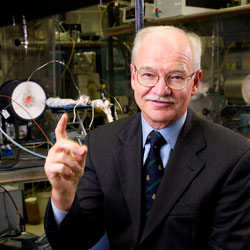To hear Ford's CTO tell it, all these painful layoffs and budget cuts going on at the company can actually be beneficial. "It gets you really focused on what's really necessary," says Gerhard Schmidt, the Chief Technology Officer at Ford.
Ford now evaluates its R&D efforts by comparing the money it spends to the percentage of fuel economy improvements it gets. "This makes you structure your portfolio for what's really key, not just what's interesting to explore," he says.
So Ford is taking a very safe, but very sound approach to the technology it's developing. And its goal is to make that technology affordable for the masses. "Henry Ford didn't invent the combustion engine," says Schmidt, "but he made it available to everybody."
John McElroy is host of the TV program "Autoline Detroit" and daily web video "Autoline Daily". Every week he brings his unique insights as an auto industry insider to Autoblog readers.
Driven by this philosophy, Ford is not that keen on diesel engines for the American market, or HCCI, or CVT transmissions, and believes that plug-ins have a long way to go. Instead, it's taking a simpler approach.
 BTW, Gerhard Schmidt joined Ford in 2000, after an illustrious career at BMW where he rose to become senior vice president in charge of all vehicle integration and powertrain development. So his credentials are impeccable.
BTW, Gerhard Schmidt joined Ford in 2000, after an illustrious career at BMW where he rose to become senior vice president in charge of all vehicle integration and powertrain development. So his credentials are impeccable.
While Ford will offer diesels in its full-size trucks and SUVs, Schmidt says the company will take a wait-and-see approach for diesels in passenger cars in the American market. The high cost of diesel fuel and emission standards are the reasons. "We'll watch our competitors," he says. If diesels catch on in mass-market numbers, Ford can quickly bring its European diesels over here. "We have all the technical solutions for Tier II Bin 5 and Bin2, but it won't be cheap," he warns.
He's also skeptical of homogeneous charge compression ignition (HCCI) engines, which are gasoline engines that act like diesels. They start up using spark plugs, then switch over to compression ignition to provide fuel economy improvements that approach a diesel.
At the present stage of development, HCCI only works well at low speeds and light loads. The challenge of going beyond this to the full RPM spectrum is seamlessly switching from spark to compression. The key word is seamlessly. It requires enormous complexity to achieve this and there are significant NVH issues to overcome.
Instead, Schmidt likes using partial stratification in direct injection, turbocharged engines. Stratification provides a rich mixture at the spark plug with a very lean charge - mostly air – in the rest of the combustion chamber. The idea is to use a stratified charge only at idle or part load. This provides nearly the same fuel economy as HCCI, but at much lower cost.
There is still a place for HCCI technology in Ford's portfolio. Schmidt says it makes more sense in hybrids and extended range EVs, where batteries and electric motors can help ease transitions from one mode to another. And series hybrids (like the Chevy Volt) are the best application, where the engine would pretty much run at a constant speed.
This also relates to why he's not that keen on continuously variable transmissions (CVTs). The advantage of these transmissions is that they allow engineers to map their engines to run at their most efficient range. But Schmidt claims that turbocharged, direct-injection gas engines already do that, so coupling them to a CVT doesn't make them more efficient. Besides, he adds, step-gear transmissions are mechanically more efficient than CVTs, and he sees a glowing future for dual-clutch automatics.
He says that using hydrogen as a fuel could have a chance depending on government policies, but in the meantime he prefers ethanol. "The goal of producing 37 billion gallons (by 2017) may be difficult to achieve," Schmidt observes, "but having 5% to 10% ethanol is a credible solution, it takes the pressure off oil demand. We have the farmers and the refineries to do it. It helps our energy diversity."
Some researchers are proposing using gasoline engines with a separate system to inject pure ethanol at wide open throttle or heavy loads to suppress detonation. Schmidt sees problems with this approach. "You need two systems of injectors and two tanks. You must have E100 available everywhere and that infrastructure isn't there," he points out. "If we can get to E25 we can get almost all the same benefits. We can raise the compression ratio and get more power and fuel efficiency."
The topics covered here merely skim the surface of all the research work taking place at Ford. But it's valuable to understand the thinking that's driving Ford's R&D.
Autoline Detroit
Airs every Sunday at 10:30AM on Detroit Public Television.
Autoline Detroit Podcast
Click here to subscribe in iTunes
Ford now evaluates its R&D efforts by comparing the money it spends to the percentage of fuel economy improvements it gets. "This makes you structure your portfolio for what's really key, not just what's interesting to explore," he says.
So Ford is taking a very safe, but very sound approach to the technology it's developing. And its goal is to make that technology affordable for the masses. "Henry Ford didn't invent the combustion engine," says Schmidt, "but he made it available to everybody."
John McElroy is host of the TV program "Autoline Detroit" and daily web video "Autoline Daily". Every week he brings his unique insights as an auto industry insider to Autoblog readers.
Driven by this philosophy, Ford is not that keen on diesel engines for the American market, or HCCI, or CVT transmissions, and believes that plug-ins have a long way to go. Instead, it's taking a simpler approach.
 BTW, Gerhard Schmidt joined Ford in 2000, after an illustrious career at BMW where he rose to become senior vice president in charge of all vehicle integration and powertrain development. So his credentials are impeccable.
BTW, Gerhard Schmidt joined Ford in 2000, after an illustrious career at BMW where he rose to become senior vice president in charge of all vehicle integration and powertrain development. So his credentials are impeccable.
While Ford will offer diesels in its full-size trucks and SUVs, Schmidt says the company will take a wait-and-see approach for diesels in passenger cars in the American market. The high cost of diesel fuel and emission standards are the reasons. "We'll watch our competitors," he says. If diesels catch on in mass-market numbers, Ford can quickly bring its European diesels over here. "We have all the technical solutions for Tier II Bin 5 and Bin2, but it won't be cheap," he warns.
He's also skeptical of homogeneous charge compression ignition (HCCI) engines, which are gasoline engines that act like diesels. They start up using spark plugs, then switch over to compression ignition to provide fuel economy improvements that approach a diesel.
At the present stage of development, HCCI only works well at low speeds and light loads. The challenge of going beyond this to the full RPM spectrum is seamlessly switching from spark to compression. The key word is seamlessly. It requires enormous complexity to achieve this and there are significant NVH issues to overcome.
Instead, Schmidt likes using partial stratification in direct injection, turbocharged engines. Stratification provides a rich mixture at the spark plug with a very lean charge - mostly air – in the rest of the combustion chamber. The idea is to use a stratified charge only at idle or part load. This provides nearly the same fuel economy as HCCI, but at much lower cost.
There is still a place for HCCI technology in Ford's portfolio. Schmidt says it makes more sense in hybrids and extended range EVs, where batteries and electric motors can help ease transitions from one mode to another. And series hybrids (like the Chevy Volt) are the best application, where the engine would pretty much run at a constant speed.
This also relates to why he's not that keen on continuously variable transmissions (CVTs). The advantage of these transmissions is that they allow engineers to map their engines to run at their most efficient range. But Schmidt claims that turbocharged, direct-injection gas engines already do that, so coupling them to a CVT doesn't make them more efficient. Besides, he adds, step-gear transmissions are mechanically more efficient than CVTs, and he sees a glowing future for dual-clutch automatics.
Having 5% to 10% ethanol is a credible solution, it takes the pressure off oil demand.
Schmidt is also a big supporter of plug-in hybrids, but says the value-for-the-money proposition is not quite there yet. "We need the battery costs at $200 per kilowatt-watt hour, which will come maybe after 2011. Right now it's between $650 and $1000," he says. Ford has a plug-in pilot program underway in Europe, and is working with a handful of battery makers from the US, Japan and Korea. And obviously, the same cost issues affect pure EVs.
He says that using hydrogen as a fuel could have a chance depending on government policies, but in the meantime he prefers ethanol. "The goal of producing 37 billion gallons (by 2017) may be difficult to achieve," Schmidt observes, "but having 5% to 10% ethanol is a credible solution, it takes the pressure off oil demand. We have the farmers and the refineries to do it. It helps our energy diversity."
Some researchers are proposing using gasoline engines with a separate system to inject pure ethanol at wide open throttle or heavy loads to suppress detonation. Schmidt sees problems with this approach. "You need two systems of injectors and two tanks. You must have E100 available everywhere and that infrastructure isn't there," he points out. "If we can get to E25 we can get almost all the same benefits. We can raise the compression ratio and get more power and fuel efficiency."
The topics covered here merely skim the surface of all the research work taking place at Ford. But it's valuable to understand the thinking that's driving Ford's R&D.
Autoline Detroit
Airs every Sunday at 10:30AM on Detroit Public Television.
Autoline Detroit Podcast
Click here to subscribe in iTunes
The video meant to be presented here is no longer available. Sorry for the inconvenience.


Sign in to post
Please sign in to leave a comment.
Continue